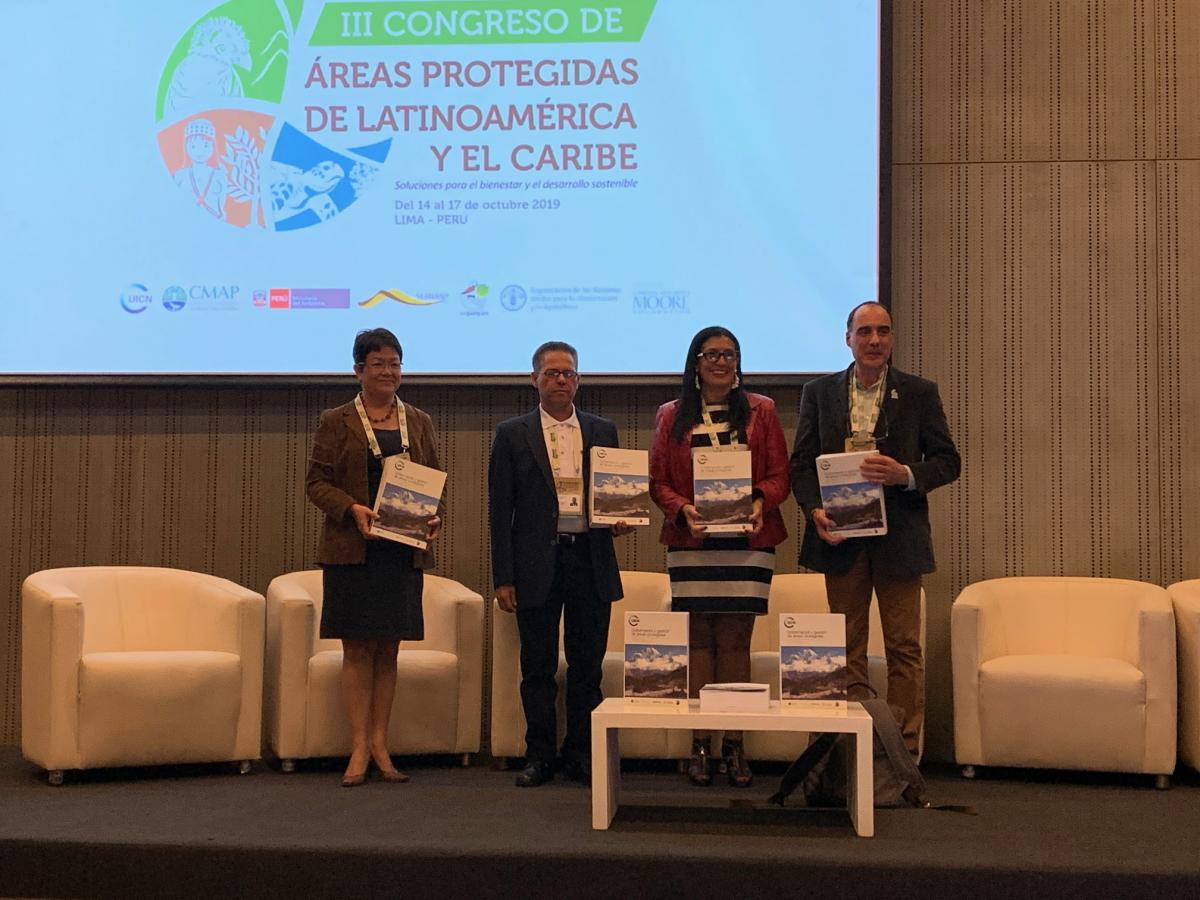Healthy marine ecosystems for the well-being of planet Earth
IUCN China was invited to participate in a media field reporting campaign named “Travel across Ecological Marine Territory” sponsored by the State Oceanic Administration of China. During the event, participants visited Juhua Island and Pan Jin municipality in Liaoning province, exploring successful cases and best practices in marine protection and restoration in China.
Oceans are the cradle of life, and coastal areas, including intertidal areas and wetlands, are rich in biodiversity and an important contributor to local economies. According to data from China in 2013, there were 35.1 million people working in marine-related fields, creating more than RMB 5,400b (US$ 786b) in economic activity.
Marine ecosystem restoration and protection were hot topics at the 2016 IUCN World Conservation Congress held in Hawai'i. Successful protection of marine ecosystems and sustainable use of marine resources are critical for climate change resilience.
International Union for Conservation of Nature China Office was invited to participate in a media field reporting campaign named “Travel across Ecological Marine Territory” sponsored by the State Oceanic Administration of China, and visit Juhua Island and Pan Jin municipality in Liaoning province to explore successful cases and best practices in marine protection and restoration in China.
Juhua Islands: Creating mutual benefits for marine economic development and ecosystem protection by ecological management of natural resources
Hu Lu Dao municipality in northeast China is an important harbour city in Liao Ning province, which has China's second longest provincial coast line of 261 km. With 3,200 square kilometres of maritime area and 33 docks in total, marine resources and marine transport are important contributors to the economy of the municipality.
Residents understand that their livelihoods depend on the marine environment, and that it is their responsibility to protect it, and the municipal authorities aim to sieze the economic opportunities of the revival of the area while preserving local ecosystems.
Thanks to the State Oceanic Administration (SOA) and local marine and fishery departments, a series of regulations and laws were published establishing a solid legal basis for effective and sustainable management of marine areas: “Blue Sea Action” led by the vice mayor of Hu Lu Dao city, safeguards marine ecosystems with scientific measures and effective management; law enforcement has been strengthened; and inland pollution control has been recognised as critical in preserving a healthy marine environment. Major companies operating coastal areas were investigated and requested to remedy inappropriate practices, and several restoration projects were initiated, such as a coastal wetland restoration project, marine protected area establishment, and the implementation of ecological aquaculture, while ocean parks became an innovative measure in promoting marine eco-civilisation in Hu Lu Dao.
Juhua Island is a successful example in developing ecological tourism while restoring biodiversity and marine ecosystems. To the southeast of Hu Lu Dao city, Juhua Island covers 13.5 square kilometres, with 27 km of coastline, and 54% forest cover. Its historical legacy as a Buddhist holy island – Juhua Temple is a popular attraction for devout Buddhists – adds to the island's allure. Due to its beautiful natural environment and rich heritage, Juhua Island was voted as one of the ten “China's most beautiful islands” in 2015.
Given its exceptional conditions, Juhua Island has set a goal of developing the green economy. Several measures were applied to fulfill the mission:
Strengthening afforestation. Robust forest ecosystems are the foundation of tourism on the island. The local oceanic and fishery department established a comprehensive strategy to maintain and extend the forest coverage rate. A seedling nursery on the island can supply 16 kinds of local trees, and a linden project was launched in 2010 aiming at cultivating a million linden on the island. In the future, more effort will be put into biodiversity conservation and environmentally friendly facilities construction.
Heritage and eco-tourism. Juhua Temple, along with natural attractions Tang Wang Cave and Stone Beach, draw around 350,000 visitors annually. Tourism accounts for more than 30% of the island's economic activity, and provides more than a third of local employment. Local livelihoods have been greatly improved by tourism income, encouraging preservation of the pristine environment.
Pan Jin Municipality: Setting an extraordinary example of intertidal restoration and management in China, protecting costal areas and migratory bird flyways.
Pan Jin municipality is located in the core area of Liao River Delta area south west of Liaoning province, and features abundant wetland and marine resources. The 21 rivers in Pan Jin form a wide, connected waterway system and large areas of wetlands and intertidal areas. As “the capital of wetlands”, Pan Jin has more than 31,500 square kilometres of wetlands, including important natural habitats for a multitude of species. Shuangtaizi Estuary National Nature Reserve, for example, was listed in RAMSAR for its indispensable role in conserving many rare and endangered birds in the Asia-Australisia flyway. Shuangtaizi is a vital feeding and breeding ground for Larus saundersi, listed as Vulnerable on the IUCN Red List of Threatened SpeciesTM, and Grus japonensis, listed as Endangered.
Suaeda heteroptera (Seepweed), brings in multiple benefits to the local marine ecosystem. Suaeda is confined to saline or alkaline soil habitats, such as coastal salt-flats and tidal wetlands, and has thick, succulent leaves, and the ability to ameliorate salty habitats. After around two years, areas populated with Suaeda can be replaced by reed, and even become paddy land after time.
In recent years, Pan Jin has introduced the innovative “rice crab symbiotic planting mode” farming method. Paddy land provides food and shelter for crabs, while the crabs contribute to pest control, and excrement for fertiliser. Today, “rice crab symbiotic planting mode” has expanded to more than 1,000 square kilometres of paddy, Pan Jin rice and Pan Jin crab have both become famous brands in China, and farmers' household annual incomes have increased.
During our short visit to Pan Jin, local authorities proudly illustrated their extraordinary examples of intertidal restoration to achieve greater economic prosperity and healthier marine ecosystems.
Restoring wetland area by ecological remediation of costal area and by returning mariculture areas to wetlands. With support from SOA, more than RMB 300m has been invested in the restoration of 40 square kilometres of coastal wetlands. More than 51 square kilometres of agricultural areas have been converted back to natural wetlands. Pollution control and water area enlargement projects were initiated at the same time to ensure the survival of water birds and other wildlife. “Blue Bay Restore Project in Pan Jin” has the goal of returning and restoring more than 33 square kilometres of mariculture areas into natural intertidal zones by 2017.
Promoting systematic development of marine protected areas in terms of Marine Park and eco-tourism, and raising public awareness of marine protection. Inland pollution discharge has caused tremendous damage to the wetland environment. Pan Jin established an integrated management plan to reconnect rivers and waterways, and to control non-point pollution from nearby village and paddy lands. A number of marine parks and scenic spots will be planed and developed according to natural conditions along the coast. Marine parks will protect undisturbed natural breeding grounds, while also providing an educational channel for the public to better understand marine protection. Scenic locations, especially the ones with spectacular view of the landscape featuring Suaeda heteroptera, commonly known as Red Beach, will provide cultural value and leisure activities for visitors. It is expected that during the thirteenth Five Year Plan, from 2016 to 2020, marine ecosystems in the Pan Jin area will be upgraded to a new level, not only in its natural protected areas, but also in public awareness.
Encouraging scientific research about effects of wetlands on climate change mitigation and adaptation. Yuan Yang Gou National Marine Park has worked with State Marine Environmental Monitoring Center to use high-tech monitoring and assessment equipment to accumulate data on water quality and carbon sequestration for some time. Its studies on the contribution of wetlands to climate change mitigation indicates that wetlands have a higher capacity for carbon sequestration than forest land. Led by Yuan Yang Gou National Marine Park, a group of protected areas are reaching-out to academia, and are contributing to studies on the benefits of healthy ecosystems and effective ecosystem management.
Healthy marine environments for the wellbeing of planet Earth
Hu Lu Dao and Pan Jin are located in the Yellow Sea Area, a vital part of the East Asian-Australasian Flyway (EAAF). IUCN Species Survival Commission (IUCN SSC) has been working with Chinese authorities on Yellow Sea conservation for many years, and IUCN encourages and supports trans-boundary cooperation in Yellow Sea conservation. In the past two years, conservation dialogues between China, South Korea, Japan and other countries were initiated, and more collaborations are expected in future.
The State Oceanic Administration, as the leader in China on Yellow Sea conservation, has demonstrated steady determination in marine ecosystem conservation and sustainable development. Juhua Island and Pan Jin are two successful examples out of many outstanding conservation stories. IUCN believes that Chinese stories and experiences play an important role in international marine ecosystem conservation, especially Yellow Sea and EAAF conservation. We also would like to establish sound collaboration and strategic partnership with SOA with our experience and techniques, and provide support to conservation programmes in future.
About the “Travel across Ecological Marine Territory”
“Travel across Ecological Marine Territory” is a campaign sponsored by the State Oceanic Administration of China, with the theme of “Promoting Green Development and Ecological Managing the Ocean”. The campaign will organise site visits for media and conservation groups in seven municipalities along the coastal area of China in 2016, to experience marine ecological civilisation development on the ground, and to collect field stories of coastal restoration and integrated marine management. The visit to Juhua Island and Pan Jin was the seventh and final trip this year, more exciting stories will be explored in more locations next year.







